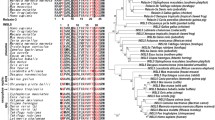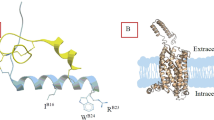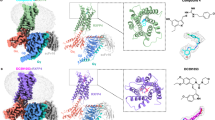Abstract
Insulin-like peptide 5 (INSL5) is an orexigenic peptide hormone belonging to the relaxin family of peptides. It is expressed primarily in the L-cells of the colon and has a postulated key role in regulating food intake. Its G protein-coupled receptor, RXFP4, is a potential drug target for treating obesity and anorexia. We studied the effect of modification of the C-terminus of the A and B-chains of human INSL5 on RXFP4 binding and activation. Three variants of human INSL5 were prepared using solid phase peptide synthesis and subsequent sequential regioselective disulfide bond formation. The peptides were synthesized as C-terminal acids (both A- and B-chains with free C-termini, i.e., the native form), amides (both chains as the C-terminal amide) and one analog with the C-terminus of its A-chain as the amide and the C-terminus of the B-chain as the acid. The results showed that C-terminus of the B-chain is more important than that of the A-chain for RXFP4 binding and activity. Amidation of the A-chain C-terminus does not have any effect on the INSL5 activity. The difference in RXFP4 binding and activation between the three peptides is believed to be due to electrostatic interaction of the free carboxylate of INSL5 with a positively charged residue (s), either situated within the INSL5 molecule itself or in the receptor extracellular loops.



Similar content being viewed by others
Abbreviations
- INSL5:
-
Insulin-like peptide 5
- mINSL5:
-
Mouse insulin-like peptide 5
- hINSL5:
-
Human insulin-like peptide 5
- IGFI:
-
Insulin-like growth factor I
- IGFII:
-
Insulin-like growth factor II
- INSL3:
-
Insulin-like peptide 3
- INSL4:
-
Insulin-like peptide 4
- INSL6:
-
Insulin-like peptide 6
- RXFP3:
-
Relaxin-family peptide receptor 3
- RXFP4:
-
Relaxin-family peptide receptor 4
- Boc:
-
tert-Butoxycarbonyl
- Acm:
-
Acetamidomethyl
- cAMP:
-
3′,5′-cyclic adenosine monophosphate
- PEG-PS:
-
Poly(ethylene glycol)-polystyrene
- CD:
-
Circular dichroism
- CHO:
-
Chinese hamster ovary
- DMF:
-
Dimethylformamide
- DIEA:
-
Diisopropylethylamine
- Fmoc:
-
9-fluoroenylmethoxycarbonyl
- GPCR:
-
G-protein coupled receptor
- HCTU:
-
O-(6-chlorobenzotriazol-1-yl)-N,N,N’,N’-tetramethyl uronium hexafluorophosphate
- INSLs:
-
Insulin-like peptides
- RXFP:
-
Relaxin-family peptide
- tBu:
-
tert-Butyl
- TIPS:
-
Triisopropylsilane
- TFA:
-
Trifluoroacetic acid
- TFMSA:
-
Trifluoromethanesulfonic acid
- DODT:
-
3,6-dioxa-1,8-octanedithiol
- DPDS:
-
2,2′-dipyridyldisulfide
- BSA:
-
Bovine serum albumin
- HEPES:
-
4-(2-hydroxyethyl)-1-piperazineethanesulfonic acid
- ERK:
-
Extracellular-signal-regulated kinase
- DMEM:
-
Dulbecco’s modified Eagle’s medium
References
Bathgate RAD, Halls ML, van der Westhuizen ET, Callander GE, Kocan M, Summers RJ (2013) Relaxin family peptides and their receptors. Physiol Rev 93:405–480
Belgi A, Hossain MA, Shabanpoor F, Chan L, Zhang S, Bathgate RAD, Tregear GW, Wade JD (2011) Structure and function relationship of murine insulin-like peptide 5 (INSL5): free C-terminus is essential for RXFP4 receptor binding and activation. Biochemistry 50(39):8352–8361
Belgi A, Bathgate RA, Kocan M, Patil N, Zhang S, Tregear GW, Wade JD, Hossain MA (2013) Minimum active structure of insulin-like peptide 5. J Med Chem 56(23):9509–9516
Conklin D, Lofton-Day CE, Haldeman BA, Ching A, Whitmore TE, Lok S, Jaspers S (1999) Identification of INSL5, a new member of the insulin superfamily. Genomics 60(1):50–56
Grosse J, Heffron H, Burling K, Hossain MA, Habib AM, Rogers GJ, Richards P, Larder R, Rimmington D, Adriaenssens AA, Parton L, Powell J, Binda M, Colledge WH, Doran J, Toyoda Y, Wade JD, Aparicio S, Carlton MBL, Coll AP, Reimann F, O’Rahilly S, Gribble FM (2014) Insulin-like peptide 5 is an orexigenic gastrointestinal hormone. Proc Natl Acad Sci 111(30):11133–11138
Haugaard-Jönsson LM, Hossain MA, Daly NL, Craik DJ, Wade JD, Rosengren KJ (2009) Structure of human insulin-like peptide 5 and characterization of conserved hydrogen bonds and electrostatic interactions within the relaxin framework. Biochem J 419(3):619–627
Haugaard-Kedström LM, Hossain MA, Daly NL, Bathgate RAD, Rinderknecht E, Wade JD, Craik DJ, Rosengren KJ (2015) Solution structure, aggregation behavior, and flexibility of human relaxin-2. ACS Chem Biol 10(3):891–900
Hossain MA, Lin F, Zhang S, Ferraro T, Bathgate RA, Tregear GW, Wade JD (2006) Regioselective disulfide solid phase synthesis, chemical characterization and in vitro receptor binding activity of equine relaxin. Int J Pept Res Ther 12(3):211–215
Hossain MA, Bathgate RAD, Kong CK, Shabanpoor F, Zhang S, Haugaard-Jönsson LM, Rosengren KJ, Tregear GW, Wade JD (2008) Synthesis, conformation, and activity of human insulin-like peptide 5 (INSL5). ChemBioChem 9(11):1816–1822
Kong RC, Shilling PJ, Lobb DK, Gooley PR, Bathgate RA (2010) Membrane receptors: structure and function of the relaxin family peptide receptors. Mol Cell Endocrinol 320(1–2):1–15
Liu C, Kuei C, Sutton S, Chen J, Bonaventure P, Wu J, Nepomuceno D, Kamme F, Tran DT, Zhu J, Wilkinson T, Bathgate R, Eriste E, Sillard R, Lovenberg TW (2005) INSL5 is a high affinity specific agonist for GPCR142 (GPR100). J Biol Chem 280(1):292–300
Najbar LV, Craik DJ, Wade JD, Salvatore D, McLeish MJ (1997) Conformational analysis of LYS(11–36), a peptide derived from the β-sheet region of T4 lysozyme, in TFE and SDS. Biochemistry 36(38):11525–11533
Scott DJ, Layfield S, Yan Y, Sudo S, Hsueh AJ, Tregear GW, Bathgate RA (2006) Characterization of novel splice variants of LGR7 and LGR8 reveals that receptor signaling is mediated by their unique low density lipoprotein class A modules. J Biol Chem 281(46):34942–34954
Shabanpoor F, Bathgate RAD, Wade JD, Hossain MA (2013a) C-terminus of the B-chain of relaxin-3 is important for receptor activity. PLoS One 8(12):e82567
Shabanpoor F, Hossain MA, Lin F, Wade JD (2013b) Sequential formation of regioselective disulfide bonds in synthetic peptides with multiple disulfide bonds. Methods Mol Biol 1047:81–87
Wang X-Y, Guo Y-Q, Shao X-X, Liu Y-L, Xu Z-G, Guo Z-Y (2014) Identification of important residues of insulin-like peptide 5 and its receptor RXFP4 for ligand–receptor interactions. Arch Biochem Biophys 558:127–132
Acknowledgments
This research was partly funded by NHMRC (Australia) project grants (1023321, 1065481, 1023078) to M. A. H, R. A. D. B and J. D. W and ARC linkage grant (LP120100654) to R. A. H. We are grateful to Tania Ferraro and Sharon Layfield for assistance with biochemical assays. During these studies, M. A. H. was the recipient of Florey Foundation Fellowships. R. A. D. B. is an NHMRC Senior Research Fellow, and J. D. W. is an NHMRC Principal Research Fellow. Studies at the FINMH were supported by the Victorian Government’s Operational Infrastructure Support Program.
Author information
Authors and Affiliations
Corresponding authors
Ethics declarations
Conflict of interest
The authors declare that they have no conflict of interest.
Research involving human participants and/or animals
This article does not contain any studies with human participants performed by any of the authors. This article does not contain any studies with animals performed by any of the authors. This article does not contain any studies with human participants or animals performed by any of the authors.
Rights and permissions
About this article
Cite this article
Patil, N.A., Bathgate, R.A.D., Kocan, M. et al. The C-terminus of the B-chain of human insulin-like peptide 5 is critical for cognate RXFP4 receptor activity. Amino Acids 48, 987–992 (2016). https://doi.org/10.1007/s00726-015-2144-5
Received:
Accepted:
Published:
Issue Date:
DOI: https://doi.org/10.1007/s00726-015-2144-5




